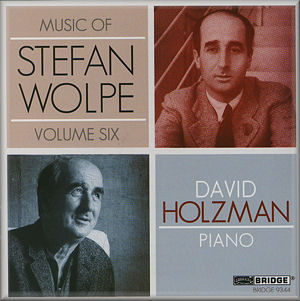 |
 |
|


alternatively
CD: MDT
AmazonUK
AmazonUS |
Stefan WOLPE (1902-1972)
Music of Stefan Wolpe - Volume 6
Four Studies on Basic Rows (1935-36) [30:24]
Three Pieces for Youngsters (1950) [2:03]
Lied, Anrede, Hymnus, Strophe zarteste Bewegung (1939) [1:13]
Two Pieces for Piano (1941) [4:14]
Toccata in Three Parts (1941) [10:57]
Studies for Piano, Part 1, Displaced Spaces (1946-48) [5:12]
Studies for Piano, Part 2 (1948) [4:10]
Two Dances for Piano (1926) [5:09]
Palestinian Notebook (1939) [6:40]
Songs Without Words (1959) [3:08]
 David Holzman (piano)
David Holzman (piano)
rec. 11-12 July, 2008; 2-4 November, 2009; 10 July 2010, Rogers
Center for the Arts, Merrimack College, North Andover, Massachusetts,
USA. DDD
 BRIDGE 9344 [73:21] BRIDGE 9344 [73:21] 
|
|
|
This excellent series of music by Stefan Wolpe, whose life spanned
the first three quarters of the last century, continues both
to perplex and to delight. To perplex because the musical character
of German exile to Palestine Wolpe was so complex, enigmatic
and diverse. To delight because of the very high quality both
of that intriguing music and its playing.
Indeed, David Holzman's first CD in the series (BRIDGE 9116)
in 2003 was nominated for 'Best Solo Instrumental Performance'
in that year's Grammys and did in fact go on to win AFIM's INDIE
award as 'Best Classical CD'. The current recital has all the
vigour, perception and delicacy of his earlier success. The
music played here was written between 1926 - before Wolpe and
Irma Schoenberg (1902-1984) emigrated to Palestine, in 1934
- and 1959 only just over a decade before his death.
Particularly noteworthy is the first complete recording of Wolpe's
huge Four Studies on Basic Rows (1935-36). It occupies
almost half this CD and includes the composer's most frequently-recorded
piano piece, the 'Passacaglia' [tr.4], which is in turn the
longest single movement here at getting on for a quarter of
an hour.
Music representing Wolpe's time in Germany, Palestine and America
is included. It varies in complexity and scope from the experimental
to music written for his students. So you're getting a mixture,
a taster, of Wolpe's output for the instrument. You're also
getting it played by undeniably the greatest interpreter of
Wolpe's keyboard music alive today.
In his essay for the CD's liner notes, Holzman describes how
he has come to know Wolpe so intimately that he can detect the
composer's most minutely expressed moods and feelings in his
music. Although this is evident from Holzman's control of tempi,
phrasing and timbral nuance, the pianist is never permissive
to the exclusion of the true musical essence which he's gently
intent on conveying. It's insight and interpretation first,
and any hint of special understanding second. The playing of
the 'Passacaglia', for instance, is approached with great confidence
and all the necessary familiarity; Holzman unshowily brings
to the performance his ability to anticipate and to pace the
music yet is as fresh and full of surprises as can be.
Holzman reveals and commends the depth and breadth as well as
the engaging beauty of these works: Wolpe's fascination with
the colours (literally) of intervals was never mechanical, forced
or self-indulgently indecisive. Holzman quietly and effectively
communicates with great conviction and confidence the gentle
and at times understated loveliness in music whose titles sound
as though they were mere exercises. They're not. Their range
and originality are impossible to miss thanks to Holzman's perception
and dedication.
His playing is alert and alive. It continually presents new
delights. Listen to the juxtaposition of the 'Pastorale' then
'Con fuoco' of the Two Pieces for Piano from 1941 [trs. 9, 10].
It's not that they could be by different composers (Berg then
Webern perhaps); nor that the same composer is as versatile
as he clearly is. The playing succeeds because it's conversant
with the wealth of resources on which Wolpe draws at any one
time. These include moods, light, invention, ties to other formats,
references and original topoi in which Wolpe is so evidently
at home. As a result, what does emerge in contrasts and parallels
somehow has its own logic.
Technically Holzman is flawless. The piano is recorded nicely
forward yet with enough space to allow full air to the many
timbres and palettes it's required to evoke. The notes, which
are nicely informative - especially for someone new to Wolpe's
world - explain the somewhat relaxed circumstances under which
this recital was prepared and executed. Indeed, there's a spontaneity
and lack of deliberateness to the playing, to the order in which
the pieces are heard and consequently to the listener's overall
delight in this slice of a very intriguing composer. But this
is a freedom which not for a minute even hints at sacrificing
the rigour necessary for music as demanding as this. The result:
an hour and a quarter's sheer enjoyment and inspiration.
This sixth volume in Bridge's series fulfils the promise of
the others released so far. It's a great introduction to Wolpe's
piano music for those unfamiliar with it. Since most of the
pieces here presented are not available elsewhere, Holzman's
recital will also satisfy collectors of Wolpe. Don't hesitate.
Mark Sealey
|
|

